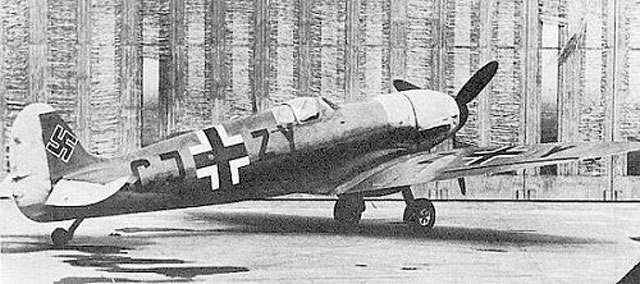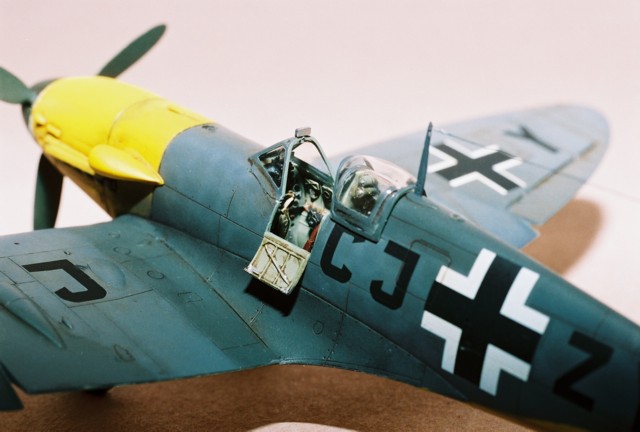|
Messerspit
by
Rian Jones
|

|
|
Messerspit |

HyperScale is proudly supported by Squadron
P/O (Sous Lt) Bernard Scheidhauer and P/O (Sous/Lt) Henri de Bordas of
131 Squadron (Free French Air Forces) departed Westhampnett, England early
on the afternoon of November 18, 1942 to undertake a “Rhubarb” into
Normandy. (A “Rhubarb”, as I was informed here on Hyperscale, was a small
scale fighter or fighter-bomber attack on the continent on ground targets
of opportunity. Normally flown in inclement weather which allowed the
fighters to retreat into the cloud should they be bounced by the Lufwaffe.)
Scheidhauer was flying a Spitfire Mk. Vb NX:X (EN830).
Making landfall on the French coast at St Aubin sur Mer they picked up
and followed the Caen River to Cherbourg, attacking several targets along
the way. During the sortie they were met by light flak and purposely
avoided Carentan because of the concentration of flak in the area. At the
small town of Ecausseville, de Bordas lost sight of his wingman, he
continued to circle for as long as he could calling out on his radio
transmitter but with no response. He returned to Westhampnett alone.

Scheidhauer's Spitifire had been hit by flak that damaged his fuel line
and he was losing fuel. His radio was also inoperable. Presumably he
became disoriented and headed west instead of north. After crossing a
stretch of water he sighted land that he mistook for the Isle of Wight.
Picking out a suitable field he placed his aircraft down in a wheels-up
landing, coming to rest in a field of turnips. Climbing from the aircraft
he was met by several locals who informed him of his navigational error,
he was in fact on the German Occupied Isle of Jersey and not the Isle of
Wight.
Scheidhauer tried to destroy the aircraft. He attempted to acquire some
petrol to set fire to it, but none was available. He smashed the
instrument panel as best he could and gave away various items of equipment
to the gathering crowd. The Germans arrived shortly thereafter and he was
taken prisoner finally ending up at Stalag Luft 111. (Scheidhauer was
eventually an escapee in the event immortalized by the film “The Great
Escape” and was one of the prisoners who was recaptured and murdered by
the Gestapo on Hitler’s orders. A memorial to him exists today on the Isle
of Jersey that includes a piece of the propeller from EN830 and his flight
helmet.)
EN830 was dismantled and shipped to the Daimler-Benz test facility at
Echterdingen. It arrived stripped of its guns and ammunition, with the gun
ports closed. The inoperable radio had been replaced with ballast, but it
still had its original Merlin 45 engine. It was reassembled and made
airworthy. Several flights were made by Daimler-Benz pilots before a
conversion was attempted. A decision was made to replace the instruments
and the entire electrical system with standard German equipment, because
the Luftwaffe used a 24 volt system, whilst the RAF used a 12 volt
standard.
While the Merlin engine was being removed, it was discovered that the
Spitfire's firewall cross-section was very close to that of the Bf 109G. A
new engine support was designed, and a standard DB 605A-1 engine (Wk-Nr
00701990) was installed. It was covered with the front cowl of a Bf. 110G.
A 3.0 m. diameter VDM propeller was installed, as was a carburetor scoop,
both from a Bf.109G. This made for a very interesting looking aircraft!
The Messerspit was born. The work was completed at the Sindelfingen
Daimler-Benz factory, near Echterdingen.
The modified Spitfire's fueled weight, without armament was 6,020 lb. The
weight with armament was estimated to be 6,681 lb. Its fueled weight with
armament, before the engine modification, had been an almost identical
6,680 lb.

Sources disagree about the color scheme. Some have the Messerspit painted
RLM 74/75 on the upper surfaces, 75 sides with 74 mottling. Others have it
RLM 70/75. Some have the lower surfaces RLM 65 and others say RLM 04. For
certain the nose, elevators and rudder were painted yellow (RLM 04).
After the modification, Flugkapitan Willy Ellenreider was the first to try
the aircraft. He was stunned that the aircraft had much better visibility
and handling on the ground than the Bf.109. It took off before he realized
it and had an impressive climb rate, around 70 ft. per second. He related
that the Spitfire's better handling could be attributed to its lower wing
loading. The Spitfire's wing area was about 54 sq. ft. greater than that
of the Bf.109. The Messerschmitt was faster at low altitude, but at 11,000
ft. the speeds evened out. The DB 605A engine gave better performance,
according to the test data, than the Merlin, which was rated 150 hp below
the German engine. It gave the Spitfire a ceiling of 41,666 ft., about
3,280 ft. more than a Bf.109G with the same engine and 5,166 ft. more than
that of a Spitfire Mk.V. After a brief period at Rechlin confirming the
performance data, the modified Spitfire returned to Echterdingen to serve
officially as a test bed. It was popular with the pilots in and out of
working hours.
Its career ended on August 14, 1944, when a formation of US B-17’s
attacked Echterdingen, wrecking nine aircraft on the ground, including
EN830. Its remains were scrapped.
Building a
Messerspit in 1/48 Scale
|
My Messerspit started life as Tamiya’s marvellous 1/48 scale Spitfire
Mk. Vb. I acquired the conversion kit from Fusion Models (Kit #4801),
which included 7 resin parts (nose, carburetor intake, spinner, propeller
blades and pitot tube), decals, instructions and a painting guide
http://www.dp9.com/Fusion/KitPages/4801.htm .

I also used Ultracast’s nicely crafted resin control surfaces set for
the Mk. Vb, which includes the ailerons, elevators and rudder
http://www.ultracast.ca/products/48/039/default.htm . I added Eduards’
PE RAF seatbelts to the interior.
The Tamiya Spitfire kit is an easy build. I first assembled the cockpit
and the fuselage. The line for cutting off the nose falls along a panel
line and is easy to accomplish with a razor saw and an Xacto knife. The
Fusion resin nose fits perfectly. I used Zap-a-Gap CA glue, which filed
the slight gap at the panel line, and rescribbed the panel line
afterwards. The ailerons, rudder and elevators were removed from the
Tamiya kit prior to assembly. Minimal clean up of the cuts was required.
Using a pin vise, holes were drilled into the butt end of Ultracast parts
at the hinges. Fine wire was glued in place with CA. The ailerons were
attached and the rudder and elevators were set aside for painting and
mounting at a later time. The wire was used to mount these parts to the
model.
Fusion provides a neat little jig and assembly drawing for attaching the
propeller blades to the spinner. Fusion’s instructions have one cement the
propeller assembly to the nose. I thought this to be too fragile and
instead drilled ¼” holes and attached a ¼” diameter rod to the back of the
spinner, slipping it through the hole drilled in the nose.
I elected to paint the model according to the Fusion instructions.
The model was painted with Tamiya Acrylics. The upper surfaces are RLM
74/75 and the sides of the fuselage are RLM 75 with RLM 74 mottling. The
undersurfaces, nose, rudder and elevators are RLM 04 (I mixed a few drops
of Tamiya Red Brown with Tamiya Flat Yellow to get what I thought looked
right). The spinner and blades are painted RLM 70 (Tamiya Flat Black
Green).
The interior is standard RAF Interior Green. The seat is painted with
Tamiya Flat Hull Red and Flat Red Brown mixed in equal portions and gloss
coated with Future to simulate bakelite. The model was then gloss coated
with Future and the decals were applied.

The Fusion decals were very thin and fragile, but look very “painted
on” once applied. The crosses were slightly out of register but nothing
that wasn’t fixable with a little trimming. Swastikas are provided, but in
two parts. I opted to use some from the spares box.
The model was weathered slightly with Newton-Windsor oils thinned with
Turpenoid. I used pastels for the exhaust stains.
A finish coat of Testor’s Dull Coat lacquer sealed everything and gave
the desired flat finish.
This was an enjoyable build and a relatively easy conversion. It makes
an attractive and unusual addition to my collection. I hope you enjoy it.
http://www.unrealaircraft.com/hy_spitfire.php
http://www.luftwaffe-experten.co.uk/supermarine.html
http://pub157.ezboard.com/fluftwaffeexperten71774frm59.showMessage?topicID=79.topic
Click on the thumbnails
below to view larger images:
Model, Images and Text Copyright ©
2004 by Rian Jones
Page Created 12 January, 2004
Last Updated
17 March, 2004
Back to
HyperScale Main Page |
Home |
What's New |
Features |
Gallery |
Reviews |
Reference |
Forum |
Search